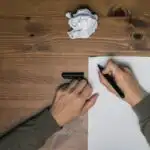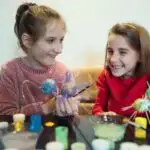For teachers, you’ll know that there’s nothing quite as satisfying as seeing a project that you’ve organized from beginning to end become a roaring success amongst your students.
Some of the most fun and exciting projects include those which are science based, as they give students the opportunity to learn about the world around them in new ways.

The tricky part is that it can be incredibly difficult to come up with new ideas that will help students to learn, but in an entertaining way.
The early years, during 3rd grade, are the pivotal points in which students can start to foster a love for the subject.
Therefore, as a teacher, you want to make sure that you’re always giving it your all in terms of new projects and activities to stimulate their imaginations.
If you’ve found yourself a little stuck, and are struggling to come up with some new ideas, then don’t worry, because we’ve got you covered.
Below, we’ve compiled a list of what we believe to be some of the most enjoyable and entertaining science projects out there suitable for 3rd graders. So, you can simply relax, read through, and choose your favorites.
To find out more, keep reading below, as we take a closer look.
1. Fossil Making
If you’re on the hunt for a fun science project where your students are actually able to make something that they can take home, then we’d recommend taking a look at this project.
This one actually allows your students to create their own fossils, which means that they can look at these for years to come, and help them with their studies.
For the fossil making project, all you need to do is gather some natural objects. This is a fun opportunity to take a nature walk with your students, and allow them to collect various things from their surroundings on the way.
For this one, as you can see, they’ve used sea shells, which make really great indentations. All you have to do after you’ve gathered the various items is to place them in a block of clay, and fill them with glue before leaving them to dry.
This is a super fun project to do with students if you’re teaching them a lesson about dinosaurs, or simply about the ancient world in general. They’ll love making their own special fossils.
2. Salt And Pepper Static Electricity
One of the fun things about doing new science projects with your class is that sometimes you learn a thing or two as well. For example, we’re sure that many of you didn’t know about this salt and pepper trick.
In order to create this project, all you’re going to need is some salt and pepper. Show your class as you mix them thoroughly together, then after you’re done, you can go ahead and create some static electricity, and watch the two of them separate again.
This one is sure to fascinate the class, and it’s a good project to demonstrate if you’re giving a science class that’s all about electricity.
3. Color Wheel Magic
This is a really easy and fun project, and can be used either within the context of science class, or art class too.
For this one, you’re going to need to cut out a piece of circular paper, and then fill it in with each of the different primary colors to make a wheel.
After you’ve done this, you can then go ahead and thread a piece of yarn through the center.
After you’ve done this, hold the yarn taughtly on either side of the string, then have one of your students spin the wheel as fast as they can.
They’ll be amazed as they watch how each of the colors blend together into one. This is a good lesson for showing how colors can be mixed together in order to create new variations.
4. Mix Up Your Own Putty Slime
Making slime has become an incredibly popular project for both teachers and parents alike in recent years, and it’s not hard to see why.
Making slime is a great way to foster children’s fine motor skills, as well as being a good sensory activity too.
When you make slime, you can add all sorts of different textures, colors, and even smells too.
But, why is it so great for science class? Well, for a host of different reasons, the primary one being that it’s a chance to teach them about polymers.
You can have them play around with a couple of different formulas, then give them the chance to create their own variations with different properties. They can take these home and play around with them too.
5. Drops Of Water On A Penny
If you’re looking for an incredibly easy science project to conduct with your class because you don’t have much time to prepare, then we’d recommend that you take a look at this super easy project.
In order to conduct this experiment, all you’re going to need is a few pieces of spare change in different sizes.
You’re going to want to place them flat on the table, then have members of the class see how many drops of water they’re able to place on the surface of the penny, without it overflowing.
This is an incredibly easy science experiment, but it does teach an important lesson about water tension. So, if you’re struggling for time, why not try this one out?
6. Defy Gravity With Magnets And Paperclips
This is a great project to take part in and introduce students to their first lesson about magnets. In order to recreate this project, you’re going to need a few key objects.
First of all, you’re going to need 4 flat magnets, some paper clips, card paper, and string.
This tutorial shows you how to assemble a small tower on both ends with multicolored card paper. After you’ve done this, you’re going to take a piece of cardboard, and attach magnets all along the surface.
Following on from this, you can go ahead and place your paperclips on some pieces of string.
After you’ve put the entire thing together, your students will be amazed at how the paperclips rise up on the string, as they’re attracted toward the magnets resting above.
This is a really fun project, and is a great supplement if you’re teaching your students about gravity and how it works.
7. Crystalized Fall Leaves
This is another project that could technically be classified as an art lesson too. This one takes some fall leaves in various colors that you can collect with your students, and turns them into works of art through the process of science.
To conduct this project, you’re going to need a few items in order to create your solution. This solution will be responsible for crystallizing your leaves, which will take a few days to be fully formed.
After you’ve completed the project, and taught them all there is to know about the process of crystallization, you can then go ahead and take these leaves, making them into fall themed decorations that you can hang around the classroom.
8. Build Your Own Water Whistle
This is another really easy and fun science project for kids. In order to conduct this experiment, you’re just going to need two things, which involve several glasses of water, and a number of straws that you can hand out to the class.
After you’ve handed out the glasses of water and straws to each member of your classroom, you can then go ahead and tell them to bend their straws into all sorts of funny shapes.
After they’ve done this, instruct them to place their straws within the glasses, where they can then go ahead and blow, making all sorts of different noises.
Students are essentially able to build their own whistles, just by using a few key items. This one is great for sensory development, as it engages both sound and touch.
9. Waterproofing Test
This project is great if you’re teaching your class about different materials. For this project, you’re going to need enough lego to go around the classroom, so that each member is able to build their own house.
After they’ve done this, they’re going to need to find some different materials that they can use to build the roof. These might include straw, wood, plastic etc… Essentially, whatever you’re able to provide them with.
After they’ve attached that specific material to the roof, they can then go ahead and test whether or not it is, indeed, waterproof.
They can do this simply by pouring a glass of water over the surface of the roof, and measuring how much has spilled through.
After they’ve finished trialing all of the different materials, you can then go through each of them in the classroom, and assess which material was the least effective, and which was the most.
10. Balloons To Explore Buoyancy
If you’re looking for a science project that’s super effective when teaching your students about the properties of buoyancy, then we think we’ve found the perfect one.
In order to conduct this experiment, all you’re going to need are some balloons, and some different items to fill them up with.
This one could potentially get a little bit messy, and requires some degree of space, so it’s perfect for doing when the weather is hot and you can go outside to teach.
In order to conduct this experiment, you’re going to need a range of different substances, such as salt, oil, water, corn syrup etc… each of which will have different levels of buoyancy.
After you’ve filled all of them up with the relevant substances, you can then go ahead and grab a large bucket, and fill it up with water.
After you’ve filled it up, you can then grab one balloon at a time, and have the class guess whether or not they think it’s going to sink or float.
You can then assess each material afterward, and teach them why some things are more buoyant than others.
11. Grow Bacteria
This is a super important science lesson, and one we think every classroom should perform. Essentially, for this experiment, you’re going to be growing bacteria from a number of different sources.
You’re going to need a few items, including several petri dishes that you can grow the bacteria inside.
After you’ve acquired the materials, you can begin filling them with different things, such as water from a fish tank, the bacteria from the surface of your hand, bacteria from the fridge, bacteria from the toilet, bacteria from the door handle etc…
After you’ve done this, you’ll need to leave the various substances in the petri dishes, and allow them to grow over a number of different days.
Your students will be amazed when they see the bacteria forming in the petri dishes, and will also likely be shocked at how dirty some of these different sources can be.
This is a great science project for teaching the importance of always washing your hands, and keeping surfaces as clean as possible.
In addition to this, growing bacteria in petri dishes will also make your students feel as though they are true scientists, and it can be a very fun experience for all involved.
12. Invisible Ink
This one is a really fun and easy science project, and is great for doing when you don’t have too much time on your hands.
In order to conduct this science project, you’re only going to need two separate items. These include cotton ear swabs, and some lemon juice.
Pour the lemon juice into a bowl, then hand out some pieces of paper to the class. They can then go ahead and dip the end of the ear swab into the lemon juice, and write something on their paper.
After they’ve managed to write something, you’re then going to need to apply heat to the page.
You can do this simply by using a nearby radiator, or a light source. The class will be amazed at the way the heat shows their writing, and makes the invisible ink visible.
13. Homemade Fly Trap
This is another fun, easy science experiment, and is also useful for getting rid of pesky bugs around the classroom too!
For this project, you’re going to need a plastic bottle with the top cut off of it, that you can fill with water. After you’ve filled the bottle halfway, then you can go ahead and add in either vinegar or honey to each.
After you’ve done this, you can take a tally chart where each member of the classroom must guess whether the bugs will be more attracted to the fly trap containing honey, or vinegar.
You can then talk about the results of your experiment at a later date after you’ve managed to collect some flies in each. This is also a good practical lesson for students.
14. Mentos And Coke
This is a super entertaining science project that I’m sure each of us remembers from their own childhoods.
It involves taking a bottle of coke, then placing a piece of mentos candy inside, and watching as it fizzes vigorously.
You can have fun experimenting with your class with this project, by alternating the size of the mentos you’re using, or adding more in. Watch as the chemical reaction gets bigger and bigger with more sweets inside.
This one is good for teaching students about chemical reactions, and how different substances act when combined together.
15. Sprout Sweet Potatoes
If you’re looking for a science project that you can conduct over time, and watch as it forms each day, then we’d recommend this fun science project.
It essentially involves taking a portion of sweet potato, then attaching some sticks to hold them up in cups.
After you’ve done this, you can then go ahead and watch as they begin to sprout over time, forming their tuberous roots.
Make sure that you’re placing them in a warm area, such as near a window, so that they’re able to acquire enough heat to start sprouting their roots.
The class will have fun checking up on these everyday to see what their progress is like. This is a great opportunity to demonstrate how different items grow, and talk a little bit about sustainability.
Final Thoughts
To sum up, there are a whole host of different fun and engaging science projects that you can create for your class.
Although it might seem tricky to come up with new ideas at first, just a little bit of research can generate a bunch of great activities.
Whether you need something fun and easy, or something a little more intricate involving several different materials, we’re sure that you’ll find it above.
We sincerely hope that we’ve managed to provide you with the inspiration that you need to get started today.
- Homeschooling In High School: Pros And Cons - February 24, 2024
- How Do I Withdraw My Child From School To Homeschool? - February 23, 2024
- How To Not Go Crazy Homeschooling Kids: A Guide For Frazzled Parents - February 22, 2024









Leave a comment